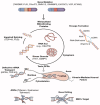Neuroaxonal Degeneration as a Converging Mechanism in Motor Neuron Diseases (MNDs): Molecular Insights into RNA Dysregulation and Emerging Therapeutic Targets
- PMID: 40806770
- PMCID: PMC12347207
- DOI: 10.3390/ijms26157644
Neuroaxonal Degeneration as a Converging Mechanism in Motor Neuron Diseases (MNDs): Molecular Insights into RNA Dysregulation and Emerging Therapeutic Targets
Abstract
Motor Neuron Diseases (MNDs) such as Amyotrophic Lateral Sclerosis (ALS), Primary Lateral Sclerosis (PLS), Hereditary Spastic Paraplegia (HSP), Spinal Muscular Atrophy with Respiratory Distress Type 1 (SMARD1), Multisystem Proteinopathy (MSP), Spinal and Bulbar Muscular Atrophy (SBMA), and ALS associated to Frontotemporal Dementia (ALS-FTD), have traditionally been studied as distinct entities, each one with unique genetic and clinical characteristics. However, emerging research reveals that these seemingly disparate conditions converge on shared molecular mechanisms that drive progressive neuroaxonal degeneration. This narrative review addresses a critical gap in the field by synthesizing the most recent findings into a comprehensive, cross-disease mechanisms framework. By integrating insights into RNA dysregulation, protein misfolding, mitochondrial dysfunction, DNA damage, kinase signaling, axonal transport failure, and immune activation, we highlight how these converging pathways create a common pathogenic landscape across MNDs. Importantly, this perspective not only reframes MNDs as interconnected neurodegenerative models but also identifies shared therapeutic targets and emerging strategies, including antisense oligonucleotides, autophagy modulators, kinase inhibitors, and immunotherapies that transcend individual disease boundaries. The diagnostic and prognostic potential of Neurofilament Light Chain (NfL) biomarkers is also emphasized. By shifting focus from gene-specific to mechanism-based approaches, this paper offers a much-needed roadmap for advancing both research and clinical management in MNDs, paving the way for cross-disease therapeutic innovations.
Keywords: DNA repair; RNA-binding proteins; axonal transport; kinase signaling; mitochondrial dysfunction; motor neuron diseases; neurofilament biomarkers; neuroinflammation; protein aggregation; targeted therapies.
Conflict of interest statement
The authors declare no conflicts of interest.
Figures


Similar articles
-
Prescription of Controlled Substances: Benefits and Risks.2025 Jul 6. In: StatPearls [Internet]. Treasure Island (FL): StatPearls Publishing; 2025 Jan–. 2025 Jul 6. In: StatPearls [Internet]. Treasure Island (FL): StatPearls Publishing; 2025 Jan–. PMID: 30726003 Free Books & Documents.
-
Short-Term Memory Impairment.2024 Jun 8. In: StatPearls [Internet]. Treasure Island (FL): StatPearls Publishing; 2025 Jan–. 2024 Jun 8. In: StatPearls [Internet]. Treasure Island (FL): StatPearls Publishing; 2025 Jan–. PMID: 31424720 Free Books & Documents.
-
Treatment for sialorrhea (excessive saliva) in people with motor neuron disease/amyotrophic lateral sclerosis.Cochrane Database Syst Rev. 2022 May 20;5(5):CD006981. doi: 10.1002/14651858.CD006981.pub3. Cochrane Database Syst Rev. 2022. PMID: 35593746 Free PMC article.
-
Emerging biomarkers in amyotrophic lateral sclerosis: from pathogenesis to clinical applications.Front Mol Biosci. 2025 Jun 30;12:1608853. doi: 10.3389/fmolb.2025.1608853. eCollection 2025. Front Mol Biosci. 2025. PMID: 40661315 Free PMC article. Review.
-
Symptomatic treatments for amyotrophic lateral sclerosis/motor neuron disease.Cochrane Database Syst Rev. 2017 Jan 10;1(1):CD011776. doi: 10.1002/14651858.CD011776.pub2. Cochrane Database Syst Rev. 2017. PMID: 28072907 Free PMC article.
References
Publication types
MeSH terms
Substances
Grants and funding
LinkOut - more resources
Full Text Sources
Research Materials
Miscellaneous

